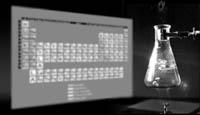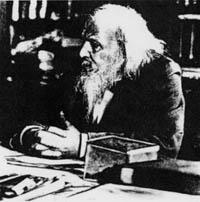Periodic Table: Northern needle of chemicals

The ancient Greeks did not like experimentation much. Moreover, the nature of matter was philosophical. However, the intellectual work of that time left important consequences. Enpedokles said that the world is made up of four elements (air, water, earth and fire) and that any material is made up of mixtures of these elements. A century later, Aristotle "invented" the fifth element: the ether that forms space. These ideas explain the concepts of elements and compounds. However, the philosophers Leuzipo and Democritus invented another more interesting concept. If the matter breaks, what size can be obtained? According to his hypothesis, indivisible subjects would become fragments. These fragments were called atoms.
Medieval chemists used more elements than the Greeks and studied their physical properties. This way we tried to locate the substances to be added or removed to transform one item into another.
Most alchemists sought to find the gold process. With this excuse, many others lived at the expense of kings and lords. Gold was therefore not considered an element. It was a mixture of various metallic substances or a surprising mixture. This idea was very sustainable. For example, physicist Isaac Newton did not consider gold as an element.
What is it?
Another prestigious scientist who believed that gold is composed was the Irish Robert Boyle. Boyle made important contributions to chemistry. One of them was the definition of the element, a basic substance that can be combined with others but cannot be distributed in other simpler ones.
This definition has the highest limit on distribution methodologies. The more advanced the chemical separation techniques, the more elements can be known. French chemist Antoine Laurent Lavoisier wrote a list of 33 elements. Today we know that some are not elements. British chemist Humphry Davy, for example, discovered that lime was made up of oxygen and another new element called calcium. He also discovered magnesium and found that chlorine considered a compound was an element.
Despite the followers of atomic theory, the British chemist John Dalton pulled the XIX out of darkness. At the beginning of the 20th century. Dalton said that each element had its own atom and that the only difference between the different atoms was its weight. The Italian chemist Amadeo Avogadro published a very important hypothesis. The two gases that occupy identical volumes have the same number of molecules. The subsequent work consisted, therefore, in measuring the weight of each element and in proposing numerous methods.
Trios

Years earlier, in 1817, the German chemist Johann Wolfgang Döbereiner discovered that the weight of strontium was between calcium and barium, and that, more importantly, families of chemical elements can be built according to their properties. He also worked with other trios of elements such as chlorobromo-iodine, sulfur -selenium-teluro and lithium-sodium-potassium. Consider that the weight of the central element of a trio should be the average of the weights of the other two. However, his work was considered an anecdote.
The method of systematic measurement of atoms weights was developed by the Swedish chemist Jons Jacob Berzelius. However, his methodology was not very successful. The Italian Stanislao Cannizzaro invented a better procedure based on the Avogadro hypothesis.
Complete the puzzle
XIX. In the mid-twentieth century a lot of elements were known. But the need to order this confusion was evident. It was not an easy task, but the French chemist Alexandre-Émile de Beguyer de Chancourtois performed his first successful performance. He ordered the elements in weight, grouping elements of similar chemical behavior into columns. Find the parity of the characteristics of the elements and numbers. De Chancourtois' table is one of the most outstanding pioneers of today.
Two years later, the British John Alexander Reina Newlands made a similar classification. He used a seven-column table and, as is done in music, followed the law of octaves. Although the work of these two chemists was not commended, the periodic table was invented. The last modification was made by Dimitri Mendeleiev.
When ordering the elements the property criterion prevailed and not the weight criterion. Moreover, Mendeleev had the courage to accept that some elements were not known. In his table there were gaps that were gradually filled. It was a reference for chemicals, so from the beginning it was also indicated what was missing.





